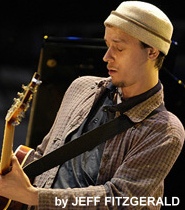Featured artist:
KURT ROSENWINKEL

There
were equal amounts of anticipation and foreboding in the smoke-free
air when Kurt Rosenwinkel mounted the stage at the Spectrum for
the 2007 Montreal
Jazz Festival. Would he live up to the highest
praises recently afforded by guitar icons John Scofield and Pat
Metheny?
From
the opening riffs, Rosenwinkel vanquished all doubts that he was
under the influence of lack of self-confidence. His unforced ease
on stage and equipoise on his instrument made it easy for the
audience to get on board for what turned out to be a surprising
and sometimes inspiring voyage. Surprising in that Rosenwinkel,
not yet 40, felt no compunction to demonstrate his technical prowess
that was nonetheless in quiet evidence, and that he was able to
induce occasional goose bumps in a genre that has been accused
of having milked itself dry as far back as the early 1980s. And
then there was Rosenwinkel’s sound, by all accounts too
close for comfort to Metheny’s, which should have worked
again him, but it didn’t because his signature ascents and
descents were of the kind that linger deliciously in the post-concert
mind.
In especially
his newer compositions, several of them from his 2005 release,
Deep Song, Rosenwinkel continues to be excited by the
idea of the guitar and sax playing together note for note, a synchronicity
whose effects are twofold: the emergent sound -- enriched to the
point where it affects physically -- feels good, and not, as one
might expect, weighty and intrusive; and when the sax bows out
the listener is delivered or released into a kind of etherscape
that induces varying degrees of light headednes. Rosenwinkel’s
partner in this unusual sound pairing, saxophonist Mark Turner,
hits and shapes all the right notes whether the guitarist is playing
singletons or his patented chordal progressions.
Adding
to this, Rosenwinkel, more than any guitarist I can think of,
is attracted to the effects produced by lateral modulation. Which
is say, when going from A and back to A, he’ll take a very
unconventional, sidereal route, which allows for shifts into keys
that would normally be excluded. This results in a very measured
build up where gratification is delayed and the unsuspecting listener
may find himself temporarily stranded or disoriented. Only when
the extended sequence returns to its origins can the protracted
development be appreciated for its deliberateness and daring,
for if the modulation isn’t underpinned by sincerity of
feeling, the shifts into unconventional keys will ring hollow.
The idea
of lateral modulation dates back to Richard Wagner (1813-1883),
who, in his operas, gave himself hours to create the desired effect.
But the concept had to wait for its purest expression in the operas
and tone poems of Richard Strauss (1864-1949), who, unlike Wagner,
availed himself of more transitional intervals, many of which
were key changes. It goes without saying that, in the context
of jazz, modulating laterally represents a new way of thinking
about music in a genre that has been stuck in compositional nowhere
land for far too long. If Rosenwinkel isn’t destined to
be a saviour, he is C-major proof that any genre worth its string
section is inexhaustible in the hands of its most inventive practitioners.
Kurt
Rosenwinkel, by staying true to his temperment, makes the case
that it’s not how far out and fast you are that lasts, but
having something to say and saying it honestly and engagingly.
By daring to take giant Steps Head, Rosenwinkel, in his Montreal
concert, satisfied listeners with memorably long lines that featured
a fluidity that belied the music’s unexpected twists and
turns. Unlike guitarists who default to clichés when imagination
is in short supply, Rosenwinkel’s narrative climaxes are
not a function of how high up on the neck of the guitar he can
play: his lyricism and melodies are strong, his concepts stronger,
which are the outcomes of the God-given ability to translate what
is deeply felt into the language of music, which is an essential
attribute of what we commonly refer to as style.
Listen
to Kurt and Mark Turner perform “Zhivago” HERE.